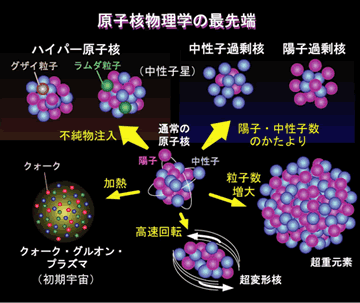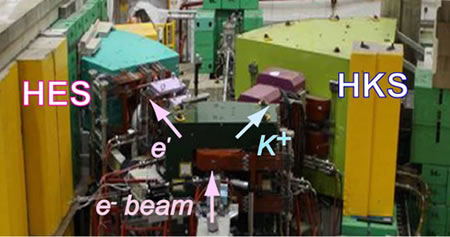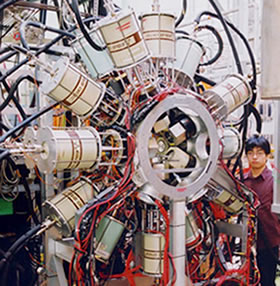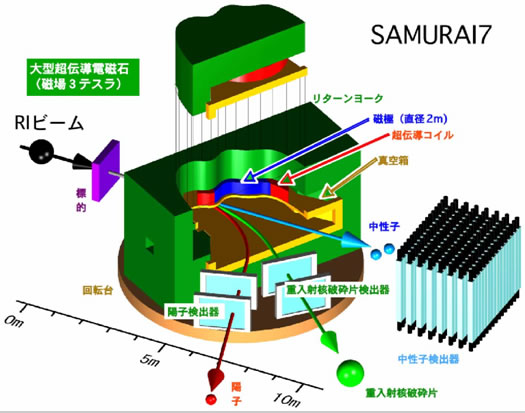Experimental Nuclear and Particle Physics
Experimental Nuclear Physics
Staff
| Professor : | Hirokazu Tamura HP | Koji Miwa | |
| Satoshi N. Nakamura HP1,HP2 | |||
| Associate Professor : | Yudai Ichikawa | Naohito Iwasa HP | Masashi Kaneta HP |
| Kenjiro Miki | Mifuyu Ukai | Takeshi Koike | |
| Assistant Professor : | Takuya Nanamura | Shuhei Hayakawa |
Research

Thanks to recent progresses of accelerator techniques, the frontier of the nuclear science is rapidly expanding. Fig.1 shows some topics of the modern nuclear physics. Now it becomes possible to produce and experimentally study various exotic nuclei under extreme conditions. Our way of understanding materials is rapidly changing due to recent progresses of those studies.
The Experimental Nuclear Physics Group of Tohoku University is experimentally investigating new types of nuclei under the extreme conditions such as : 1) hypernuclei which contain hyperon (baryon with “strangeness” quantum number like Lambda and Xi particles) in addition to normal nucleons, 2) proton/neutron rich nuclei which are unstable nuclei with a large asymmetry in the proton/neutron numbers and 3) three body force between nucleons consisting nucleus. We utilize accelerator facilities around the world and use various beams such as π/K mesons, electrons, radioisotope nuclei and polarized deuterons. We aim 1) to understand many body problem of hadrons interacting through strong interaction based on quark picture by using “strangenss” as a probe, 2) to make clear the structure of unstable nuclei far from Heisenberg’s valley and 3) to clarify three body force between nucleons. In order to proceed the above research projects, we are also designing experiments and developing apparatus for the J-PARC 50 GeV PS (proton synchrotron) in Tokai and the Radio Isotope Beam Factory at RIKEN, which were recently completed.
1. Hypernuclear Physics
The goal of hypernuclear physics (or “strangeness nuclear physics”) is the fundamental understanding of many-body hadron systems from the quark level through strangeness. We can explore deeply inner regions of nuclei with a hyperon which is free from nucleons’ Pauli principle. In addition, various modifications of nuclear structure induced by a hyperon often go beyond our common knowledge in nuclear physics. Structure of hypernuclei enables us to study hyperon-nucleon interactions, which extend our knowledge on nuclear force toward unified understanding of baryon-baryon interactions. Though there is no stable hypernuclei on the earth, theories speculate that the inner part of neutron star is so dense to have hyperons stably (hyperon star). Study of hypernuclei with accelerators will play key role to understand the inner structure of neutron/hyperon stars.
We are carrying out pioneering and unique experimental studies. (1) Recently, we succeeded in high-resolution Λ hypernuclear spectroscopy by the (e, e´K+) reaction at Jefferson Lab in U.S. for the first time. In order to explore this new research field, we had constructed and tested two major spectrometers, the High-resolution Kaon Spectrometer (HKS) and High-resolution Electron Spectrometer (HES) in Japan. Those two spectrometers were exported to U.S. and installed at Jefferson Lab (Fig.2). We successfully took data for various hypernuclei up to A=52 with HKS and HES in 2009. Now analysis and design of next project are in progress. (2) We recently succeeded in observing hypernuclear γ rays for the first time with a large germanium detector array (Hyperball) and are exploring fine structure of Λ hypernuclei with this new technique. Now we are constructing an upgraded apparatus (Hyperball-J) for a new experiment at the high intensity kaon facility, J-PARC which just starts to deliver beam. (3) We succeeded for the first time in measuring neutral K meson from deuteron by introduction of GeV γ-ray at Research Center for Electron Photon Science, Tohoku University. An upgraded apparatus (NKS2) has recently been constructed for further studies. Study of charged kaon electroproduction is also in progress at MAMI-C, Mainz, Germany.
Those research projects are carried out under the international collaboration which Tohoku group plays a key role. Our group is one of the major research groups for strangeness nuclear physics in the world.


2. Physics of exotic nuclei and nuclear force
(1) Study of exotic nuclei with RI-beam
Another extreme form of nuclei is found at the extreme neutron/proton ratio. Those nuclei are far from the stability line (Heisenberg’s valley) and located near the neutron(proton) drip line. Unlike many stable nuclei, the main features of such exotic nuclei are governed by the small number of active nucleons. Interesting phenomena are observed such as neutron halos (skins), soft giant dipole resonances, changes of the magic numbers, etc. Recently, it has become possible not only to produce such nuclei but also to use them as high-intensity high-purity secondary nuclear beams (RI beams). The group conducts experiments of those exotic nuclei using the accelerator facilities at RIKEN and National Institute of Radiological Sciences. We study (1) single particle states by nucleon knockout reactions, (2) density distribution of nucleus by proton elastic scattering process, and (3) nucleosynthesis from cross sections of nuclear reactions important inside stars. In order to proceed those studies, we are now constructing a new Superconducting Analyzer for MUlti-particle from RAdIoactive beam with 7 Tm bending power (SAMRAI7) with a collaboration of RIKEN, TITECH at RIKEN RIBF. As seen in Fig.4, a large super conducting magnet is a key element of SAMURAI7 and we are in charge of construction of the magnet and detectors for heavy-ion/protons. The analyzer will be completed in 2011.

(2) Study of three-body force between nucleons by polarized beam
Investigation of nuclear force is essential to understand structure of nucleus which is many-body system of nucleons. So far nuclear force has been understood based on meson exchange picture between two nucleons, however, the importance of three-body force between nucleons has been recently realized. In order to understand the three-body nuclear force, we are carrying out experiments with spin-polarized deuteron beams at RIKEN RIBF.

